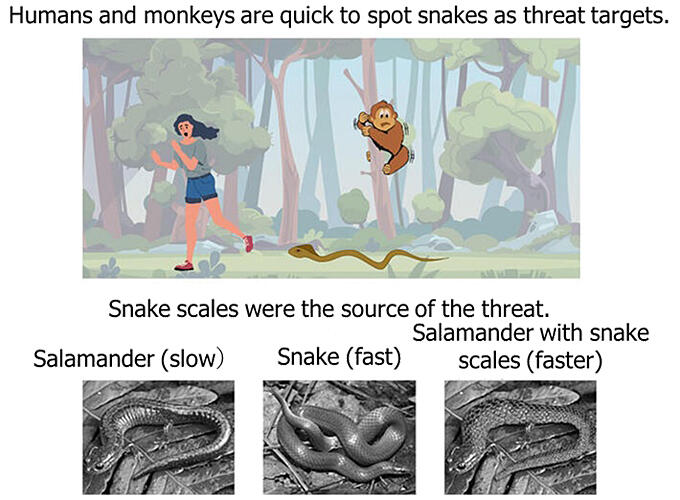We instinctively feel scared when we see a snake. Professor Nobuyuki Kawai of Nagoya University's Graduate School of Informatics investigated this and has revealed that the scales are responsible for detecting the associated threat. The results were published in Scientific Reports.

Provided by Nagoya University
According to the World Health Organization, 81,000-138,000 people die each year from snakebites. Aside from humans and parasites, snakes are the creatures that take the largest number of human lives. Snakes have been predators since the appearance of primates on Earth. The threats from snakes have been suggested to be innate by various studies, including those showing that monkeys and young children who have never seen snakes can quickly find snake pictures. However, it was unclear which visual features of the snakes make humans and primates feel threatened by them.
In this study, three monkeys who had never seen real snakes participated in an experiment, choosing the single deviant from nine animal pictures. A comparison of the lengths of time required to select the snake picture from a set including eight salamander pictures and that required to select the salamander picture from a set including eight snake pictures showed that all three monkeys took shorter lengths of time to select the snake picture. This is consistent with previous findings that snakes were found more quickly than other animals. This experiment also showed that snakes were found more quickly than salamanders, with an elongated body and tail.
Furthermore, pictures of the same salamanders as in the above experiment except that they were clothed in snake scales through image processing were used for comparison with the snake pictures. Two monkeys found the snakes and salamanders with scales in the same length of time, and one monkey found the salamanders with scales even more rapidly than the snakes. There was no difference between the snake and salamander pictures except that the salamanders were snake-scale cladded. Thus, the differences in time taken to find the deviant in the presence and absence of snake scales in the salamander pictures indicate that the monkeys reacted sensitively to the snake scales.
The rapid detection of threats is thought to be mediated by a direct pathway from the retina to the amygdala via the superior colliculus-pulvinar without going through the cortex, rather than sequential processing of information from the retina followed by transmission to the amygdala, which is the fear center. The pulvinar has neurons that respond to snake scale-like patterns and actively respond to pictures of snakes. Thus, the pulvinar and the cortical areas closely associated with it are likely to be responsible for snake detection.
During evolution, ancestors of primates assumedly developed their visual system to detect the characteristic scales of snakes as a defense against snakes, which had been their only predator for millions of years. Snake scales are drawn all over the background of the table of contents page of the book "Hebi Onna (Snake Woman; published in English under the title Reptilia)," a masterpiece by Kazuo Umezu, a manga artist who recently passed away. In the book, the mother of the protagonist girl describes the snake woman as "she has scales all over her body, her mouth ripped open to her ears, and her face looks awful." Perhaps Umezu was aware that snake scales make people feel scared.
Journal Information
Publication: Scientific Reports
Title: Japanese monkeys rapidly noticed snake-scale cladded salamanders, similar to detecting snakes
DOI: 10.1038/s41598-024-78595-w
This article has been translated by JST with permission from The Science News Ltd. (https://sci-news.co.jp/). Unauthorized reproduction of the article and photographs is prohibited.




